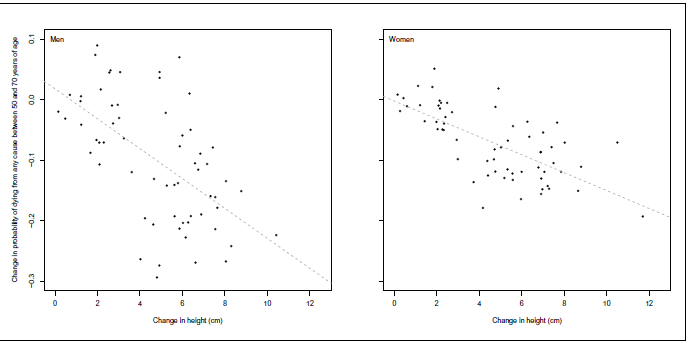Falling Behind
It’s good to be tall.
Tall people tend to be more highly educated, earn more over their careers, are higher in the social pecking order, and live longer with better health.
[Please don’t complain to me that these statement are untrue or unfair: these are true as generalizations, and I can cite the studies if you insist; these are fair because, well, maybe they’re not fair. But that’s not my department.]
By better health, I mean a lower risk of cardiovascular and respiratory diseases and less risk of adverse pregnancy outcomes, although there is a greater risk of some cancers. The charts below, for men, and women, respectively, show the relationship (it’s negative) between height (x-axis) and the probability of dying from any cause (y-axis), ages 50-70, between 1896 and 2006 among 62 countries.

We may be inclined to blame (or thank) our parents for being short (or tall), and that’s fair: height is certainly a heritable trait. So, it really is our parents’ fault.
But across populations, differences are attributed to non-genetic, or environmental, factors. Specifically, fetal growth and nutrition and infections during childhood and adolescence are important determinants of adult height. As such, height is a handy, single measure of a population’s health and longevity, but also of its education and economic productivity.
The good news is that both men and women are taller today than they were 100 years ago, in every single country. The biggest gains were found among Iranian men and South Korean women, who added an average 16.5 cm and 20.2 cm (6.5 – 8 inches), respectively, in height over the past century. Big gains were also seen in Japan, Greenland, Serbia and Poland. Modest gains were found throughout sub-Saharan Africa and South Asia.
The tallest people on the planet are Dutch men (an average of 182.5 cm, a hair under 6 feet) and Latvian women. Actually, Latvian men are now 4th tallest in the world and Dutch women are second. Basketball scouts should spend more time in Latvia and the Netherlands.
A century ago, American men and women ranked 3rd and 4th tallest, respectively, in the world. Today, we have slipped to 37th and 42nd (see maps below of relative world height of men in 1896 (top) and 1996 (below)).

This is an outrage! Americans need to get taller. One approach would be to improve fetal health, provide better nutrition and immunization to children. But the results won’t be measurable for a few generations.
Given the urgency of the height deficit in America, I suggest we offer immediate citizenship to anyone from Latvia and the Netherlands. We can begin to address our lagging height, and expand our pool of basketball talent. That just seems like good public policy.

